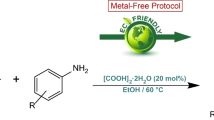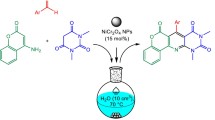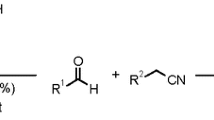Abstract
This investigation discloses a greener reaction to prepare pyrrole derivatives. Metal-free catalysts are greener alternatives to existing metal catalysts in synthetic organic chemistry. Indeed, transition metals are often costly and toxic. They may be found as traces in health reaction products such as pharmaceuticals. Alternatively small organic molecules termed “organocatalysts” allow the synthesis of valuable products without traces of toxic metals. Here, we show for the first time the use of vitamin B1 as new organocatalyst for the Paal–Knorr pyrrole synthesis under ambient conditions. Reaction conditions were optimized for the reaction of hexane-2,5-dione with 4-methoxyaniline. Ethanol was the most effective solvent. The conversion was quantitative using vitamin B1, by comparison with a low yield of 30 % without catalysis. The best conditions were performed in ethanol with 5 mol % of vitamin B1 during 1 h. This reaction was tested using various aromatic amines. To conclude the use of vitamin B1 for the Paal–Knorr pyrrole, cyclocondensation has mild reaction conditions, is simple to perform, and gives moderate to excellent yields. It is therefore a promising reaction for the preparation of various pyrrole derivatives.

Similar content being viewed by others
References
Abid M, Spaeth A, Török B (2006) Solvent-free solid acid-catalyzed electrophilic annelations: a new green approach for the synthesis of substituted five-membered N-heterocycles. Adv Synth Catal 348:2191–2196
Agarwal S, Cämmerer S, Filali S, Fröhner W, Knöll J, Krahl MP, Reddy KR, Knölker H-J (2005) Novel routes to pyrroles, indoles and carbazoles–applications in natural product synthesis. Curr Org Chem 9:1601–1614
Aghapoor K, Mohsenzadeh F, Talebian Sh, Jafar Tehrani M, Balavar Y, Khanalizadeh G, Darabi HR (2011) Vitamin B1 as a metal-ion-free natural catalyst for sustainable quinoxaline ring condensation under sonochemical conditions. Monatsh Chem 142:619–624
Bag S, Vaze VV, Degani MS (2006) Microwave assisted benzoin condensation using thiamine as catalyst. J Chem Res 4:267–269
Ballini R, Barboni L, Bosica G, Petrini M (2000) 2,5-Dialkylfurans and nitroalkanes as source of 2,3,5-trialkylpyrroles. Synlett 3:391–393
Balme G (2004) Pyrrole syntheses by multicomponent coupling reactions. Angew Chem Int Ed 43:6238–6241
Banik BK, Samajdar S, Banik I (2004) Simple synthesis of substituted pyrroles. J Org Chem 69:213–216
Banik BK, Banik I, Renteria M, Dasgupta SK (2005) A straightforward highly efficient Paal–Knorr synthesis of pyrroles. Tetrahedron Lett 46:2643–2645
Biava M, Porretta GC, Poce G, Supino S, Sleiter G (2007) New pyrroles with potential antimycobacterial, antifungal and selective COX-2 inhibiting activities. Synthetic methodologies. Curr Org Chem 11:1092–1112
Chen J, Wu H, Zheng Z, Jin C, Zhang X, Su W (2006) An approach to the Paal–Knorr pyrroles synthesis catalyzed by Sc(OTf)3 under solvent-free conditions. Tetrahedron Lett 47:5383–5387
Chen J-X, Liu M-C, Yang X-L, Ding J-C, Wu H-Y (2008) Indium(III)-catalyzed synthesis of N-substituted pyrroles under solvent-free conditions. J Braz Chem Soc 19:877–883
Chen J, Yang X, Liu M, Wu H, Ding J, Su W (2009) Approach to synthesis of β-enamino ketones and pyrroles catalyzed by gallium(III) triflate under solvent-free conditions. Synth Commun 39:4180–4198
Curini M, Montanari F, Rosati O, Lioy E, Margarita R (2003) Layered zirconium phosphate and phosphonate as heterogeneous catalyst in the preparation of pyrroles. Tetrahedron Lett 44:3923–3925
Danks TN (1999) Microwave assisted synthesis of pyrroles. Tetrahedron Lett 40:3957–3960
Darabi HR, Tahoori F, Aghapoor K, Taala F, Mohsenzadeh F (2008) NH4Cl-CH3OH: an efficient, acid- and metal-free catalyst system for the synthesis of quinoxalines. J Braz Chem Soc 19:1646–1652
Enders D, Wang C, Liebich JX (2009) Organocatalytic asymmetric Aza-Michael additions. Chem Eur J 15:11058–11076
Ferreira VF, De Souza MCBV, Cunha AC, Pereira LOR, Ferreira MLG (2001) Recent advances in the synthesis of pyrroles. Org Prep Proced Int 33:411–454
Fürstner A (2003) Chemistry and biology of roseophilin and the prodigiosin alkaloids: a survey of the last 2,500 years. Angew Chem Int Ed 42:3582–3603
Fürstner A, Szillat H, Gabor B, Mynott R (1998) Platinum- and acid-catalyzed enyne metathesis reactions: mechanistic studies and applications to the syntheses of streptorubin B and metacycloprodigiosin. J Am Chem Soc 120:8305–8314
Goswami S, Hazra A (2009) One-step direct conversion of heterocyclic aldehydes to esters. Chem Lett 38:484–485
Jacobi PA, Coutts LD, Guo J, Hauck SI, Leung SH (2000) New strategies for the synthesis of biologically important tetrapyrroles. The ‘‘B, C + D + A’’ approach to linear tetrapyrroles. J Org Chem 65:205–213
Joshi U, Pipelier M, Naud S, Dubreuil D (2005) Ring contraction methodology for the synthesis of pyrroles. Curr Org Chem 9:261–288
Kluger R (1987) Thiamine diphosphate: a mechanistic update on enzymic and nonenzymic catalysis of decarboxylation. Chem Rev 87:863–876
Kluger R, Tittmann K (2008) Thiamin diphosphate catalysis: enzymic and nonenzymic covalent intermediates. Chem Rev 108:1797–1833
Lei M, Ma L, Hu L (2009) Thiamine hydrochloride as an efficient catalyst for the synthesis of amidoalkyl naphthols. Tetrahedron Lett 50:6393–6397
Lei M, Ma L, Hu L (2010) A convenient one-pot synthesis of formamide derivatives using thiamine hydrochloride as a novel catalyst. Tetrahedron Lett 51:4186–4188
List B (2007) Introduction: organocatalysis. Chem Rev 107:5413–5415
Louloudi M, Hadjiliadis N (1994) Structural aspects of thiamine, its derivatives and their metal complexes in relation to the enzymatic action of thiamine enzymes. Coord Chem Rev 135–136:429–468
Malandrinos G, Louloudi M, Hadjiliadis N (2006) Thiamine models and perspectives on the mechanism of action of thiamine-dependent enzymes. Chem Soc Rev 35:684–692
Mandhane PG, Joshi RS, Nagargoje DR, Gill CH (2010) An efficient synthesis of 3,4-dihydropyrimidin-2(1H)-ones catalyzed by thiamine hydrochloride in water under ultrasound irradiation. Tetrahedron Lett 51:3138–3140
Merino P, Marqués-López E, Tejero T, Herrera RP (2009) Organocatalyzed strecker reactions. Tetrahedron 65:1219–1234
Mikolajek R, Spiess AC, Büchs J (2007) Feasibility of gas/solid carboligation: conversion of benzaldehyde to benzoin using thiamine diphosphate-dependent enzymes. J Biotech 129:723–725
Minetto G, Raveglia LF, Taddei M (2004) Microwave-assisted Paal–Knorr reaction. A rapid approach to substituted pyrroles and furans. Org Lett 6:389–392
Noonan C, Baragwanath L, Connon SJ (2008) Nucleophilic carbene-catalysed oxidative esterification reactions. Tetrahedron Lett 49:4003–4006
Pellissier H (2007) Asymmetric organocatalysis. Tetrahedron 63:9267–9331
Pimpim RS, Rubega CCC, de Bravo RVF, Kascheres C (1997) An efficient one-step thiamine catalyzed synthesis of furil and its analogues. Synth Commun 27:811–815
Samadjar S, Becker FF, Banik BK (2001) Montmorillonite KSF-mediated facile synthesis of pyrroles. Heterocycles 55:1019–1022
Schmuck C, Rupprecht D (2007) The synthesis of highly functionalized pyrroles: a challenge in regioselectivity and chemical reactivity. Synthesis 20:3095–3110
Schreiner PR (2003) Metal-free organocatalysis through explicit hydrogen bonding Interactions. Chem Soc Rev 32:289–296
Sheenan JC, Hara T (1974) Asymmetric thiazolium salt catalysis of the benzoin condensation. J Org Chem 39:1196–1199
Song G, Wang B, Wang G, Kang Y, Yang T, Yang L (2005) Fe3+-montmorillonite as effective, recyclable catalyst for Paal–Knorr pyrrole synthesis under mild conditions. Synth Commun 35:1051–1057
Stamatis A, Malandrinos G, Butler IS, Hadjiliadis N, Louloudi M (2007) Intermediates of thiamine catalysis immobilized on silica surface as active biocatalysts for α-ketoacid decarboxylation. J Mol Catal A: Chem 267:120–128
Takemoto Y (2005) Recognition and activation by ureas and thioureas: stereoselective reactions using ureas and thioureas as hydrogen-bonding donors. Org Biomol Chem 3:4299–4306
Tan B, Shi Z, Chua PJ, Li Y, Zhong G (2009) Unusual domino Michael/Aldol condensation reactions employing oximes as N-selective nucleophiles: synthesis of N-hydroxypyrroles. Angew Chem Int Ed 48:758–761
Texier-Boullet F, Klein B, Hamelin J (1986) Pyrrole & pyrazole ring closure in heterogeneous media. Synthesis 5:409–411
Wang B, Gu Y, Luo C, Yang T, Yang L, Suo J (2004) Pyrrole synthesis in ionic liquids by Paal–Knorr condensation under mild conditions. Tetrahedron Lett 45:3417–3419
Yadav JS, Reddy BVS, Eeshwaraiah B, Gupta MK (2004) Bi(OTf)3/[bmim]BF4 as novel and reusable catalytic system for the synthesis of furan, pyrrole and thiophene derivatives. Tetrahedron Lett 45:5873–5876
Zhang Z-H, Li J–J, Li T-S (2008) Ultrasound-assisted synthesis of pyrroles catalyzed by zirconium chloride under solvent-free conditions. Ultrason Sonochem 15:673–676
Author information
Authors and Affiliations
Corresponding author
Rights and permissions
About this article
Cite this article
Darabi, H.R., Aghapoor, K., Darestani Farahani, A. et al. Vitamin B1 as a metal-free organocatalyst for greener Paal–Knorr pyrrole synthesis. Environ Chem Lett 10, 369–375 (2012). https://doi.org/10.1007/s10311-012-0361-7
Received:
Accepted:
Published:
Issue Date:
DOI: https://doi.org/10.1007/s10311-012-0361-7




